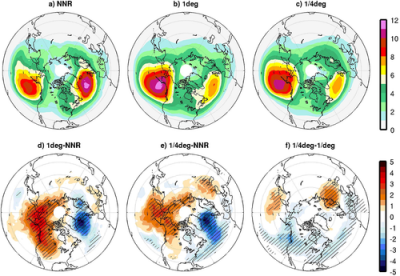Dissecting the Mechanisms of Atmosphere Blocking and their Representation in High Resolution E3SM v0.3
Understanding atmospheric blocking, or large-scale persistent flow anomalies, is critical for extreme weather prediction at the Earth's surface. This article is an analysis of how well the prerelease Energy Exascale Earth System Model (E3SM) reproduces blocking with two configurations: one that resolves the global scale flow and one that is able to capture finer scale features, using grid resolutions of ∼100 and ∼25 km, respectively. A diagnosis of the mean flow and a timescale analysis of an ensemble of simulations show the sources of blocking differences. Overlaying E-vectors, height tendencies, and vorticity fluxes separate the role of low and high-frequency eddies in the formation, maintenance, and decay of these events.
Both models generally correctly reproduce the location and distribution of blocks over the Northern Hemisphere; however, the finer-scale model is more accurate over the North Pacific region. Both models underestimate the number of blocks over the North Atlantic. We analyze the mean flow and find that the jet stream is displaced toward the pole and has a more realistic speed in the fine-scale model. This improvement appears linked to the ability to capture more finer-scale eddies, which are associated with blocking. The discrepancy implies that both fine-scale and low-frequency eddies are important in determining North Pacific blocking, whereas North Atlantic blocking is mainly driven by low-frequency eddies, which are not improved with resolution. Both model resolutions produce blocks that last too long; however, the fine-scale model is closer to observations
Understanding atmospheric blocking, or large-scale persistent flow anomalies, is critical for extreme weather prediction at the Earth's surface. Therefore, we analyze how well the prerelease Energy Exascale Earth System Model (E3SM) reproduces blocking with two configurations: one that resolves the global scale flow and one that is able to capture finer scale features, using grid resolutions of ∼100 and ∼25 km, respectively. Both models generally correctly reproduce the location and distribution of blocks over the Northern Hemisphere; however, the finer-scale model is more accurate over the North Pacific region. Both models underestimate the number of blocks over the North Atlantic. We analyze the mean flow and find that the jet stream is displaced toward the pole and has a more realistic speed in the fine-scale model. This improvement appears linked to the ability to capture more finer-scale eddies, which are associated with blocking. The discrepancy implies that both fine-scale and low-frequency eddies are important in determining North Pacific blocking, whereas North Atlantic blocking is mainly driven by low-frequency eddies, which are not improved with resolution. Both model resolutions produce blocks that last too long; however, the fine-scale model is closer to observations.

